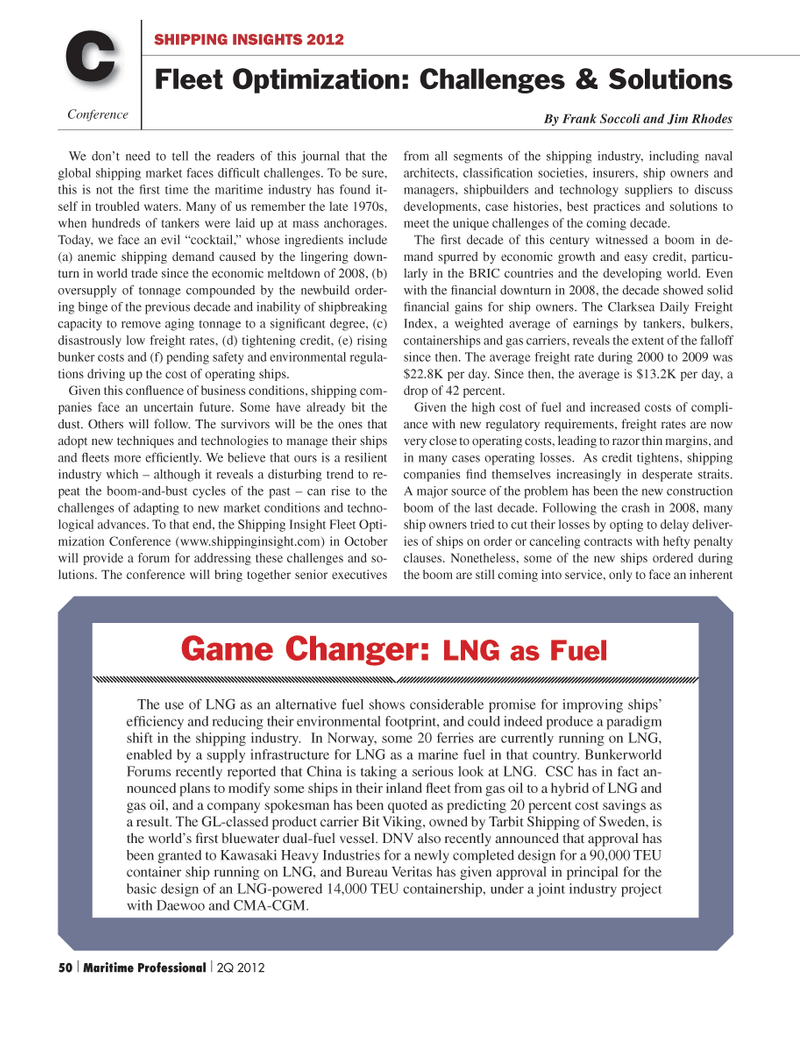
Page 50: of Maritime Logistics Professional Magazine (Q2 2012)
Maritime Risk
Read this page in Pdf, Flash or Html5 edition of Q2 2012 Maritime Logistics Professional Magazine
Conference
SHIPPING INSIGHTS 2012
Fleet Optimization: Challenges & Solutions
C
By Frank Soccoli and Jim Rhodes
We don’t need to tell the readers of this journal that the global shipping market faces diffi cult challenges. To be sure, this is not the fi rst time the maritime industry has found it- self in troubled waters. Many of us remember the late 1970s, when hundreds of tankers were laid up at mass anchorages.
Today, we face an evil “cocktail,” whose ingredients include (a) anemic shipping demand caused by the lingering down- turn in world trade since the economic meltdown of 2008, (b) oversupply of tonnage compounded by the newbuild order- ing binge of the previous decade and inability of shipbreaking capacity to remove aging tonnage to a signifi cant degree, (c) disastrously low freight rates, (d) tightening credit, (e) rising bunker costs and (f) pending safety and environmental regula- tions driving up the cost of operating ships.
Given this confl uence of business conditions, shipping com- panies face an uncertain future. Some have already bit the dust. Others will follow. The survivors will be the ones that adopt new techniques and technologies to manage their ships and fl eets more effi ciently. We believe that ours is a resilient industry which – although it reveals a disturbing trend to re- peat the boom-and-bust cycles of the past – can rise to the challenges of adapting to new market conditions and techno- logical advances. To that end, the Shipping Insight Fleet Opti- mization Conference (www.shippinginsight.com) in October will provide a forum for addressing these challenges and so- lutions. The conference will bring together senior executives from all segments of the shipping industry, including naval architects, classifi cation societies, insurers, ship owners and managers, shipbuilders and technology suppliers to discuss developments, case histories, best practices and solutions to meet the unique challenges of the coming decade.
The fi rst decade of this century witnessed a boom in de- mand spurred by economic growth and easy credit, particu- larly in the BRIC countries and the developing world. Even with the fi nancial downturn in 2008, the decade showed solid fi nancial gains for ship owners. The Clarksea Daily Freight
Index, a weighted average of earnings by tankers, bulkers, containerships and gas carriers, reveals the extent of the falloff since then. The average freight rate during 2000 to 2009 was $22.8K per day. Since then, the average is $13.2K per day, a drop of 42 percent.
Given the high cost of fuel and increased costs of compli- ance with new regulatory requirements, freight rates are now very close to operating costs, leading to razor thin margins, and in many cases operating losses. As credit tightens, shipping companies fi nd themselves increasingly in desperate straits.
A major source of the problem has been the new construction boom of the last decade. Following the crash in 2008, many ship owners tried to cut their losses by opting to delay deliver- ies of ships on order or canceling contracts with hefty penalty clauses. Nonetheless, some of the new ships ordered during the boom are still coming into service, only to face an inherent
Game Changer: LNG as Fuel
The use of LNG as an alternative fuel shows considerable promise for improving ships’ effi ciency and reducing their environmental footprint, and could indeed produce a paradigm shift in the shipping industry. In Norway, some 20 ferries are currently running on LNG, enabled by a supply infrastructure for LNG as a marine fuel in that country. Bunkerworld
Forums recently reported that China is taking a serious look at LNG. CSC has in fact an- nounced plans to modify some ships in their inland fl eet from gas oil to a hybrid of LNG and gas oil, and a company spokesman has been quoted as predicting 20 percent cost savings as a result. The GL-classed product carrier Bit Viking, owned by Tarbit Shipping of Sweden, is the world’s fi rst bluewater dual-fuel vessel. DNV also recently announced that approval has been granted to Kawasaki Heavy Industries for a newly completed design for a 90,000 TEU container ship running on LNG, and Bureau Veritas has given approval in principal for the basic design of an LNG-powered 14,000 TEU containership, under a joint industry project with Daewoo and CMA-CGM. 50 | Maritime Professional | 2Q 2012
MP #2 50-64 NEW STYLES.indd 50 5/4/2012 6:26:25 PM

 49
49

 51
51
